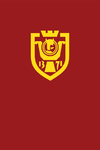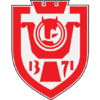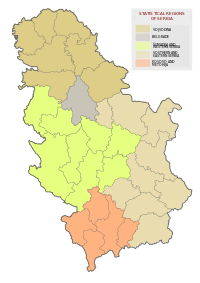Kruševac
| Kruševac Крушевац | |||
|---|---|---|---|
| City | |||
|
The Kosovo Heroes Square | |||
| |||
 Location of the municipality of Kruševac within Serbia | |||
| Coordinates: 43°35′N 21°19′E / 43.583°N 21.317°ECoordinates: 43°35′N 21°19′E / 43.583°N 21.317°E | |||
| Country |
| ||
| District | Rasina | ||
| Settlements | 101 | ||
| Government | |||
| • Mayor | Dragi Nestorović | ||
| Area[1] | |||
| • Municipality | 854 km2 (330 sq mi) | ||
| Population (2011 census)[2] | |||
| • Town | 58,745 | ||
| • Municipality | 128,752 | ||
| Time zone | CET (UTC+1) | ||
| • Summer (DST) | CEST (UTC+2) | ||
| Postal code | 37000 | ||
| Area code | +381 37 | ||
| Car plates | KŠ | ||
| Website |
www | ||
Kruševac (Serbian Cyrillic: Крушевац [krûʃeʋat͡s]) is a city and the administrative center of the Rasina District, in Serbia. It is located in the valley of West Morava, on Rasina river. According to the 2011 census, the administrative area has a population of 128,752, while the town has 58,745.
The city was founded in 1371, by Prince Lazar of Serbia (1371–1389), who used it as his seat.
History
The etymology is derived from the Serbian word for "river stone", krušac which was largely used for a building at that time.

Kruševac was founded in 1371, as a fortified town in the possession of Lord Lazar Hrebeljanović. The Lazarica Church (or Church of St, Stephen) was built by Lazar between 1375–78, in the Morava architectural style.[3] It is mentioned in one of Lazar's edicts in 1387, as his seat, when he affirmed the rights of Venetian merchants on Serbian territory. In preparation for the Battle of Kosovo (1389) against the Ottoman Empire, the Serbian army assembled in the city. The site of Lazar's palace is marked by a ruined enclosure containing a fragment of the tower of his spouse Princess Milica, and, according to legend, tidings of the defeat were brought to her by crows from the battlefield. After the battle, the city was held by Princess Milica as her seat. The little that remains of Lazar's city is the Kruševac Fortress, which was declared a Cultural Monument of Exceptional Importance in 1979.[4] Several old Ottoman houses were left at the beginning of the 20th century, besides an old Turkish fountain and bath, which was known as Alacahisar (Aladža Hisar) during Ottoman rule between 1427-1833 (nominally to 1867) when Kruševac was the seat of the Sanjak of Kruševac. The Ottoman rule was interrupted during Austrian occupations between 1688–1690 and 1717-1739.
A large monument dedicated to the fallen Serbs at the Battle of Kosovo was sculpted by Petar Ubaković (1852–1910). A part of the monument is also a statue of the famous blind Serbian poet Filip Višnjić.
Settlements
Aside from the city of Kruševac, which is the urban administrative center, the municipality includes the following 101 settlements:
- Kruševac
- Begovo Brdo
- Bela Voda
- Belasica
- Bivolje
- Bovan
- Bojince
- Boljevac
- Brajkovac
- Bukovica
- Buci
- Velika Kruševica
- Velika Lomnica
- Veliki Kupci
- Veliki Šiljegovac
- Veliko Golovode
- Veliko Krušince
- Vitanovac
- Vratare
- Vučak
- Gavez
- Gaglovo
- Gari
- Globare
- Globoder
- Gornji Stepoš
- Grevci
- Grkljane
- Dvorane
- Dedina
- Dobromir
- Doljane
- Donji Stepoš
- Đunis
- Žabare
- Zdravinje
- Zebica
- Zubovac
- Jablanica
- Jasika
- Jošje
- Kamenare
- Kaonik
- Kapidžija
- Kobilje
- Komorane
- Konjuh
- Koševi
- Krvavica
- Kukljin
- Lazarevac
- Lazarica
- Lipovac
- Lovci
- Lukavac
- Ljubava
- Majdevo
- Makrešane
- Mala Vrbnica
- Mala Reka
- Mali Kupci
- Mali Šiljegovac
- Malo Golovode
- Malo Krušince
- Mačkovac
- Meševo
- Modrica
- Mudrakovac
- Naupare
- Padež
- Pakašnica
- Parunovac
- Pasjak
- Pepeljevac
- Petina
- Pozlata
- Poljaci
- Ribare
- Ribarska Banja
- Rlica
- Rosica
- Sebečevac
- Sezemče
- Slatina
- Srndalje
- Srnje
- Stanci
- Suvaja
- Sušica
- Tekije
- Trebotin
- Trmčare
- Ćelije
- Cerova
- Crkvina
- Čitluk
- Šavrane
- Šanac
- Šašilovac
- Šogolj
- Štitare
Demographics (2011 census)
| Ethnic group | Population |
|---|---|
| Serbs | 122,529 |
| Roma | 2,461 |
| Montenegrins | 282 |
| Macedonians | 200 |
| Croats | 107 |
| Yugoslavs | 86 |
| Total | 128,752 |
Politics
Seats in the municipality parliament won in the 2012 local elections:[5]
| Party | Seats |
|---|---|
| PZP | 20 |
| SNS | 18 |
| SPS, JS | 14 |
| DS | 12 |
| DSS | 6 |
Famous residents
- Stojan Protić (1857–1923), Yugoslav politician, Prime Minister of Yugoslavia 1918-1919, 1920
- Stanislav Binički (1872–1942), Serbian composer (Marš na Drinu)
- Taško Načić (1934–1993), Serbian actor
- Miodrag Petrović Čkalja (1924–2003), One of the most popular Serbian comedians
- Bata Paskaljević (1923–2004), Serbian actor
- Dobrica Ćosić (b. 1921), Serbian writer, first President of FR Yugoslavia
- Miroslav Mišković (b. 1945), Serbian businessman
- Dragiša Binić (b. 1961), Serbian footballer, 1990–91 European Cup winner
- Milić Jovanović (b. 1966), Serbian footballer, 1990–91 European Cup winner
- Nikola Milošević (b. 1993), Serbian footballer
- Predrag Jovanović (b. 1950), Serbian musician
- Nebojša Bradić (b. 1956), Serbian theater director, and former Minister of Culture
- Goran Grbović (b. 1961), Yugoslav basketball player, bronze medalist at the EuroBasket 1987
- Vojin Ćetković (b. 1971), Serbian actor
- Nataša Tapušković (b. 1975), Serbian actress
- Tijana Bogdanović (b. 1998), Serbian taekwondo practitioner, silver medalist at the 2016 Summer Olympics
- Ljiljana Jovanović (1930-2012), Serbian actress
International relations
Twin towns — Sister cities
Kruševac is twinned with:
|
Other forms of cooperation and city friendship similar to the twin/sister city programmes:
|
Gallery
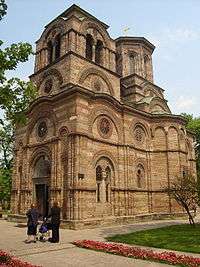 Lazarica church.
Lazarica church. Belfry.
Belfry. Middle Ages era ruins in Kruševac.
Middle Ages era ruins in Kruševac. Lazar Hrebeljanović's statue in Kruševac.
Lazar Hrebeljanović's statue in Kruševac. Filip Višnjić's statue in Kruševac.
Filip Višnjić's statue in Kruševac.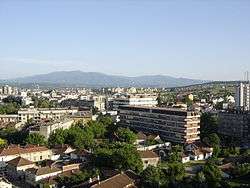 Kruševac panorama.
Kruševac panorama. Kruševac panorama.
Kruševac panorama.
See also
References
- ↑ "Municipalities of Serbia, 2006". Statistical Office of Serbia. Retrieved 2010-11-28.
- ↑ "2011 Census of Population, Households and Dwellings in the Republic of Serbia: Comparative Overview of the Number of Population in 1948, 1953, 1961, 1971, 1981, 1991, 2002 and 2011, Data by settlements" (PDF). Statistical Office of Republic Of Serbia, Belgrade. 2014. ISBN 978-86-6161-109-4. Retrieved 2014-06-27.
- ↑ Filip Jovanovic i Djordje Banovic. "Istorija - Crkva Lazarica - Kruševac - Srpska Pravoslavna Crkva". Lazarica.rs. Retrieved 2013-03-26.
- ↑ Monuments of Culture in Serbia: ЦРКВА СВ.СТЕФАНА ЛАЗАРИЦА СА КРУШЕВАЧКИМ ГРАДОМ (SANU) (Serbian) (English)
- ↑ Politicke stranke u lokalnom parlamentu
- ↑ "AllCorfu.Com: Corfu's Twin Cities". allcorfu.com. Retrieved 25 February 2010.
External links
| Wikimedia Commons has media related to Kruševac. |
- Kruševac Municipal Website
- Internet portal Kruševac - Independent Website
- KruševacPRESS - the first private owned officially registered Kruševac-based Internet media
- Kruševčki internet portal 37000.info
- Kruševac Online
- Politički portal Rasinskog okruga
- Kruševac Info portal grada
- Swimming club Napredak Kruševac
